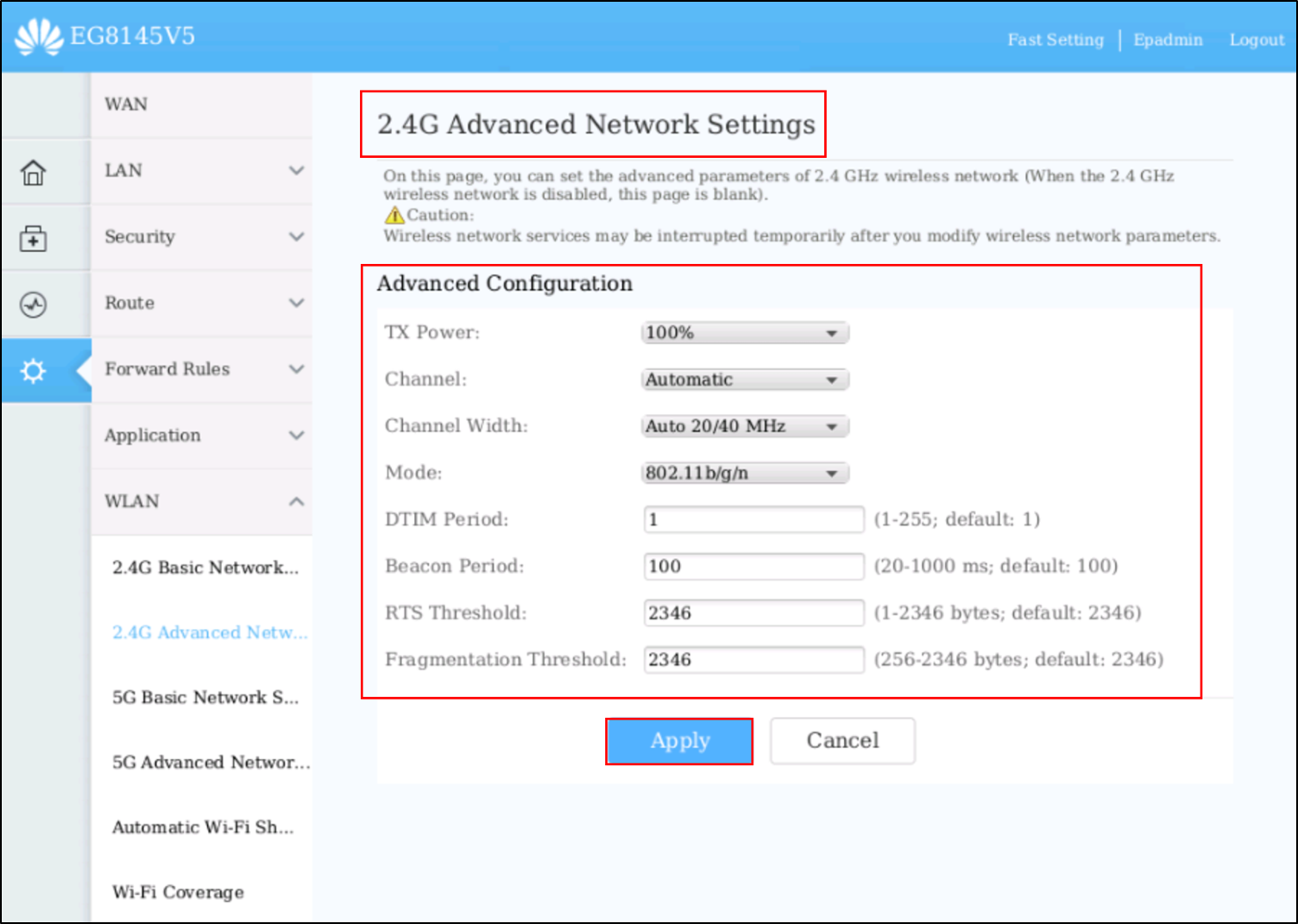Huawei ONT WiFi Configure:
Huawei EG8145V5 model ONT is used as an example to configure Huawei ONT Wifi.
1. Log in ONT WebUI of the EG8145V5. (To login Huawei HG8145V5 ONT, Open your web browser and type the default IP Address 192.168.100.1 in the address bar, then you should see the ONT login page with 2 text fields where you can type a username and a password. Default User: Epadmin Password: adminEp, You need to ensure your PC/Laptop IP address same subnet like 192.168.100.20/24.
2. Click the Advanced Configuration > WLAN tab, you can configure Wi-Fi on the WLAN Basic Configuration tab and WLAN Advanced Configuration tab respectively.
WLAN Basic Configuration:

The related parameters are described as follows:
- Number of Associated Devices
The Number of Associated Devices ranges from 1 to 32 or from 1 to 64, depending on the device’s capability. However, the maximum parameter value is not used on the actual network. If too many Wi-Fi devices are connected, the Wi-Fi Internet access experience is poor.
- Broadcast SSID
Indicates whether to enable or hide broadcast.
If the option box is selected, it indicates that the SSID broadcast function is enabled. The ONT periodically broadcasts the SSID, that is, the name of the wireless network. In this way, any STA can search for the wireless network.
If the option box is not selected, it indicates that the SSID broadcast function is disabled. The SSID is hidden, and the STA cannot search for the wireless network. The SSID can be obtained only through a request.
- Authentication Mode
Indicates the authentication mode for the STA to request access to the wireless network.
The Authentication mode varies with the device model, depending on the capability of the device. The mode can be Open, Shared, WPA Pre-Shared Key, WPA2 Pre-Shared Key, WPA/WPA2 Pre-Shared Key, WPA Enterprise, WPA2 Enterprise, or PA/WPA2 Enterprise.
It is set to open by default, that is, the STA can access the network without authentication.
- Encryption Mode
Indicates the encryption mode for the STA to request access to the wireless network. The encryption mode and encryption parameters vary with the authentication mode.
If the authentication mode is set to Open, the encryption mode can be set to None or WEP.
If the authentication mode is set to Shared, the encryption is WEP.
If the authentication mode is set to WPA Pre-Shared Key, WPA2 Pre-Shared Key, WPA/WPA2 Pre-Shared Key, WPA Enterprise, WPA2 Enterprise or WPA/WPA2 Enterprise, the encryption mode can be set to AES, TKIP, or TKIP&AES.
WEP is an insecure encryption algorithm. Therefore, using AES, TKIP, TKIP&AES, or an algorithm with a higher security level is recommended.
- WPS mode
You can select the PBC, PIN, or AP-PIN.
WLAN Advanced Configuration

The related parameters are described as follows:
- Regulatory Domain
Indicates the country code of the wireless network.
- Channel
Indicates the channel of the wireless network. The channel varies with the value of Regulatory Domain.
- Channel Width
Indicates the wireless channel width. It can be set to Auto 20/40 MHz, 20 MHz or 40 MHz.
- Mode
Indicates the supported wireless network mode.
It can be set to 802.11b, 802.11g, 802.11b/g, or 802.11b/g/n.
The mode varies with the device model, depending on the capability of the device.
- DTIM Period
Indicates the delivery period of the delivery traffic indication map (DTIM).
The value ranges from 1 to 255, and the default value is 1.
- Beacon Period
Indicates the delivery period of the beacon.
The beacon is used to contact other access point devices or network control devices.
The value ranges from 20 ms to 1000 ms, and the default value is 100 ms.
- RTS Threshold
Indicates the request to send (RTS) threshold. It is used to avoid conflicts in data transmission in the wireless LAN.
The smaller the RTS threshold, the higher the transmission frequency of RTS packets, and the faster of the system recovers from an interruption or conflict. However, more bandwidths are used, which affects the throughput of other network data packets.
The value ranges from 1 bytes to 2346 bytes, and the default value is 2346 bytes.
- Fragmentation Threshold
Indicates the fragment threshold. When the size of a packet is greater than this threshold, the packet will be fragmented. If the transmission of fragments is interrupted, only the parts that are not successfully transmitted need to be retransmitted.
The value ranges from 256 bytes to 2346 bytes, and the default value is 2346 bytes.
The specific configuration needs to be performed based on the network parameters of the area where the is located. Improper parameter settings may not affect basic Wi-Fi functions, but severely affect Wi-Fi performance and user experience.
Note:
- If the device supports both 2.4 GHz Wi-Fi and 5 GHz Wi-Fi, the Configuration of 2.4 GHz Wi-Fi and 5 GHz Wi-Fi will be differentiated under the WLAN menu.
- If the device supports only 2.4 GHz Wi-Fi, only the WLAN Basic Configuration and WLAN Advanced Configuration tabs are available by default.
You can see Huawei ONT wifi configure by U2000 NMS this topic.

